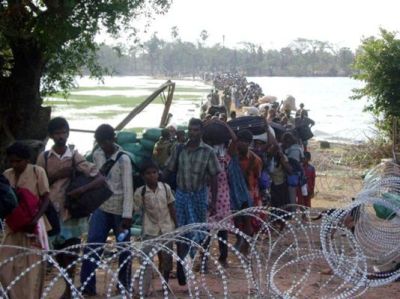      |
|
Contact us at: sooddram@gmail.com |
COVER STORY
FINAL
HOURS
B.
MURALIDHAR REDDY(Frontline)
in the war zone
An eyewitness account of the last 70 hours of Eelam War IV.
The Frontline
issue dated June 5, 2009, carried a report containing the observations of
this correspondent inside the war zone between May 13 and 16. The Hindu group
got embedded with the military for the first time in Eelam
War IV, which began in August 2006, and was attached to 58 Division of the Sri
Lanka Army. The division, headed by Brigadier Shavendra
Silva, was in the forefront of the war in the north until the last shot was
fired sometime on May 18-19.
The
journalists of The Hindu/Frontline and All India Radio/Doordarshan, the only foreign print and electronic media
outfits allowed access, took the call on May 16 to extend their stay in the war
zone as it became clear that the end of the Liberation Tigers of Tamil Eelam (LTTE) was near. The visit was facilitated by Defence Secretary Gotabaya Rajapaksa, younger brother of President Mahinda
Rajapaksa and one of the architects of the government
victory in Eelam War IV.
There were
no conditions spelled out on the coverage from the war zone. We were allowed
unfettered and unhindered movement up to about 400 metres
from the zone, where pitched battles were fought between the military and the
remaining cadre and leaders of the LTTE. We also got an occasional peep, under
the watchful eyes of senior officers, into the operations room at the
headquarters of 58 Division, where 24/7 imagery of the war zone, obtained by
Unmanned Aerial Vehicles, were beamed on small and large television screens. In
addition, the military conducted tours, often 300 to 400 metres
away from the last battle zone, once the ground situation was under the firm
control of the forces.
Most
important was the fact that we had interference-free access to the Internet,
including TamilNet, the website perceived to be
pro-LTTE and based somewhere in Europe. Within the constraints of Internet time
available, and not-unexpected problems of connectivity and speed in a war zone,
there was just enough time to read and absorb the reports on the website before
sending news dispatches to our headquarters. No questions were asked.

INSIDE THE WAR zone near Mullaithivu. This photograph was released by the Sri Lankan
military on May 18.
It must be
said that the ‘journalistic team’ associated with TamilNet
did a marvellous job of relaying the scenes of the
last hours of Eelam War IV as they unfolded.
Obviously, they were in regular touch with LTTE leaders in the war theatre.
The news,
nuggets and nuances that reflected in the TamilNet
reportage, minus the blatant propaganda that both sides excelled in, gave a
fairly good idea of the last hours and minutes as experienced and relayed by
the last batch of Tiger cadre and the LTTE top brass.
A close
scrutiny of the information war waged by the two parties in cyberspace showed
to the discerning eye that neither side hid much in real terms. Both sides, for
reasons that only objective military experts may know, were extremely careful
on what they could let the world know in the final hours of the war. In
practical terms, can war and the rules of engagement co-exist? An embedded
scribe is not qualified to attempt an answer to this question.
Here is an
account of what I saw and heard and otherwise sensed in the last 70 hours of Eelam War IV. The clock begins at 3 p.m. on May 16, where
the narrative published in the previous issue ended, and stops at 12.30 p.m. on
May 19, when army chief Lt Gen. Sarath Fonseka announced to the world: “A few hours ago on Tuesday
morning [May 19], our ground troops confirmed that they have recovered the dead
body of the world’s most ruthless terrorist leader. I make this disclosure with
responsibility and pleasure as millions of Sri Lankans as well as the army
would be the most delighted at this news.”
LTTE
ACCEPTS DEFEAT
Information
gathered by this correspondent from a group of the last batch of 80,000
civilians to flee the LTTE-occupied zone reveals that the Tigers made a
determination on May 10 that they had lost the war and that no purpose would be
achieved by holding on to the civilians. However, it is not clear on what note
they wanted to end the war.
On May 11,
the Tigers seemed to have deserted the sentry points, dismantled the defence lines and destroyed everything they could. The
exodus of the last batch of civilians started on May 12/13 and perhaps by the
night of May 15 there were no civilians left in the 1.5-square-kilometre area
the Tigers were boxed into.

CIVILIANS WALKING ACROSS a lagoon
from the "No-Fire Zone". This picture was released by the military on May 17.
The accounts
of the last hours provided by the civilians by and large tallied with the
evidence that has surfaced so far. The detention of Sea Tiger chief Soosai’s family by the Navy on May 15/16 and the discovery
of Prabakaran’s aged parents in a camp by the
military on May 27 provided the ultimate proof that the Tigers had decided to
spare the lives of the civilians they held.
The May 15
decision of the International Committee of the Red Cross (ICRC) – the only
outfit present inside the war zone until four days before the war ended – to
suspend humanitarian operations inside the Tiger-held territory proved beyond
doubt that the overwhelming majority of the civilians were out of the battle
zone and that the military and the Tigers were engaged in no-holds-barred
fight. The beaming faces of the commanders and troops spoke volumes about the
fate that awaited the Tigers.
On May 16,
President Rajapaksa declared at the G-11 Summit in
Jordan that the LTTE had been defeated, even as troops moved in to flush out
the remaining Tiger cadre and leaders holed up in the area. On that day the
number of civilians who fled to government-controlled territory touched 20,000,
while over 30,000 waited to cross over.
Citing
intercepted communication, the Defence Ministry
surmised that LTTE leaders and cadre were preparing for mass suicide after all
escape routes had been cut off. Soosai’s wife told
her military interrogators that Prabakaran was inside
the war zone along with his son Charles Anthony, Tiger intelligence chief Pottu Amman and Soosai.
From the
operations room I could see smoke bellowing from the battle zone, which troops
believed was the result of the Tigers setting fire to property and ammunition. TamilNet said: “An uncounted number of dead bodies, between
2,000 and 3,000, are lying all over the place in civilian congested area and
the civilians are all struck by a heavy stench of dead bodies.”
Rajapaksa told the G-11 Summit that the defeat of the LTTE
heralded a new era in Sri Lanka and provided all Sri Lankans a new opportunity
for peace and development. He announced that he would return to Sri Lanka “as a
leader of a nation that vanquished terrorism”.
Frontline learnt from impeccable sources that
from Jordan Rajapaksa sent a message to the ICRC that
his government was ready even at that late stage to accept the surrender of the
Tiger leaders if it was unconditional. The message was duly conveyed but the
initiative failed because the Tigers were ready to surrender only to a third
party and not to the military.
“Many in the
world believed that the LTTE is invincible, but I am proud to announce at this
august gathering that my government, with the total commitment of our armed
forces, has in an unprecedented humanitarian operation, finally defeated the
LTTE militarily,” Rajapaksa told the G-11 Summit.
He added
that efforts were under way to complement the humanitarian mission with a
political solution. “History has taught us that solutions externally
prescribed, with little understanding of the complexity of the problem on the
ground, are prone to failure. My government is, therefore, firmly committed to
seeking a home-grown solution acceptable to all communities living in Sri
Lanka,” he said.
COAST
IS CLEARED
The endgame
inside the war zone began early on May 16, with soldiers freeing the last
remaining coastal stretch that the LTTE held. The link-up marked the first time
that the military had total control of the Island’s coastline in three decades.
However, questions loomed in the minds of commanders on the whereabouts of the
LTTE top brass, including the supremo.
On May 17,
the military and the Tigers were engaged in one of the most intense battles
witnessed during the 33-month-old Eelam War IV. The
military operations began at 5 a.m. and loud explosions could be heard in the
battle zone throughout the day. The Tigers waged a hopeless battle in a bid to
prolong the inevitable, if not exactly to save the LTTE top brass.
KP’S
STATEMENT
In a
statement to TamilNet, the head of the LTTE’s
international affairs, K. Pathmanathan (KP), said:
“We need to do everything within our means to stop this carnage. If this means
silencing our arms and entering into a peace process, that is something that we
have already agreed to.” The statement made no reference either to the
government’s demand for unconditional surrender or to the whereabouts of the
LTTE top brass.
On his
arrival from Jordan in the early hours of May 18, Rajapaksa
knelt down in prayer at the Bandaranaike International Airport near Colombo. At
the G-11 Summit he had declared that he would go to a country where all
citizens had been liberated from the terrorism of the LTTE.
KP’s
statement said: “This battle has reached its bitter end. Against all odds we
have held back the advancing Sinhalese forces without help or support, except
for the unending support of our people. It is our people who are dying now from
bombs, shells, illness and hunger. We cannot permit any more harm to befall
them. We remain with one last choice – to remove the last weak excuse of the
enemy for killing our people. We have decided to silence our guns. Our only
regrets are for the lives lost and that we could not hold out for longer. We
can no longer bear to see the innocent blood of our people being spilled.”
“We are
extremely saddened that this plea has fallen on deaf ears,” it said and
appealed to the international community to take immediate measures to save the
Tamil people caught in the war zone and take necessary action to protect the
cadre and people giving themselves up to the military.
Referring to
“silencing our arms and entering a peace process”, Pathmanathan
said: “This is the need of the hour. These are historically unprecedented times
and require historically prudent decisions. If this means saving the lives of
thousands of people, it needs to be done.”
The
statement also said:
“There is
not a person who can doubt the LTTE’s fearless and unending commitment to this
cause, with which we have been entrusted by our people. Know that the Tamils
are a people deeply rooted in culture and history. No force can prevent the
attainment of justice for our people. Our sons and daughters have taken up this
call without question and without hesitation or fear of death.
“None have
hesitated to make the supreme sacrifice for the cause of liberating their
motherland. We have not forgotten that it is for our people that we fight. In
the face of the current conditions, we will no longer permit this battle to be
used as a justification by the forces of the Sinhala state to kill our people.
We willingly stand up with courage and silence our guns. We have no option
other than to continue our plea to the international community to save our
people.”
18
LEADERS DEAD
The curtain
came down on Eelam War IV in the early hours of May
18 with the decimation of the LTTE’s military capabilities in a 22-hour battle,
which also resulted in the death of at least 18 of its top leaders. There was
no clarity at that juncture about whether Prabakaran
was among the dead.
On the
afternoon of May 18 the army chief went on record to state that the military
commanders were unable to confirm the death of Prabakaran
as they had not been able to trace him or his body in the combing operations.
He pointed to unconfirmed reports that troops sighted Prabakaran
jumping into a white ambulance in a bid to flee and opened fire. The ambulance
then went up in flames. Reports also said the forces believed that a body burnt
beyond recognition that they recovered from the battle zone could be that of Prabakaran.
This
correspondent accompanied the top commanders to the spot where bodies of the
LTTE brass were brought in tractors for identification. It was less than 100 metres from where LTTE leaders were last holed up. The
commanders said the bodies whose identities had been confirmed by the military
included those of Charles Anthony, the elder son of Prabakaran;
Pottu Amman, the Tiger intelligence wing chief; B. Nadesan, the political wing head; and S. Pulithevan, the peace secretariat in-charge. There was no
word on Prabakaran, and subsequently it became known
that the military was not certain about Pottu Amman.
Along with the
bodies of LTTE leaders lined up inside the war zone, the military also put on
display the captured weapons, ammunition, communication equipment and several
bundles of Sri Lankan currency. Most of the leaders appeared to have died
either of gunshot wounds or in suicide blasts triggered by the cadre. A few
appeared to have swallowed the cyanide capsule.

The
intensity of the battle could be gauged from the fact that the bodies of at
least 250 Tiger cadre had been found until then. The commanders on the spot
believed that several more bodies could be lying in bunkers. In the evening, in
the national capital, the chiefs of the Army, the Navy and the Air Force called
on Rajapaksa and informed him that the war had
concluded. The President rewarded them all with a promotion to a higher rank.
The first sign that the military had overwhelmed the
remaining cadre and leaders of the LTTE came at around 10 a.m. at the
headquarters of 58 Division. Soldiers passed around cakes and the personnel inside
the operations room appeared totally relaxed.
Around the
same time, confirmation of the news that it was all over for the LTTE came in
the form of a feature on TamilNet. Titled “Long live
human dignity, shame on international community,” it read, “While the so-called
international community is exposed in its shameful conning,” thousands of Tamil
civilians and combatants are laying down their lives to “uphold Tamil dignity
and human dignity”.
LTTE’S
PLEA
Later in the
day TamilNet said that around 3 a.m. Wanni local time on May 18, Nadesan
and Pulithevan had telephoned their contacts in
Europe and asked them to tell the ICRC head office that only around 1,000
wounded cadre, civil officials of the LTTE and civilians remained in the
so-called safety zone and that there was no firing from the LTTE side.
“They urged
the ICRC to evacuate the wounded. A few hours later, Colombo’s Defence Ministry website claimed finding the dead bodies of
Nadesan, Pulithevan, Ilango (Tamileelam police chief),
and LTTE leader V. Pirapaharan’s son Charles Antony.
The LTTE is yet to confirm, but initial reports indicate a determined massacre
by the Sri Lanka Army (SLA),” the website said.
In Colombo,
U.N. Secretary-General Ban Ki-moon’s special envoy
Vijay Nambiar called on Rajapaksa
and Foreign Minister Rohitha Bogollagamma
and discussed the ground situation in the north as well as the welfare of the
2.75 lakh displaced civilians. Nambiar
had arrived ahead of an official visit by Ban Ki-moon
hours after the military announced that it had wiped out the LTTE’s military
capabilities.
In a
statement, the ICRC said that for nine consecutive days it had pursued efforts
to reach the area of north-eastern Sri Lanka hard hit by fighting. It said the
ICRC had been unable to obtain first-hand information about the needs of the
civilians and wounded people though thousands of civilians had fled the
conflict zone in the past days and weeks.
TamilNet launched a no-holds-barred attack on the government
and the international community hours after the LTTE’s defeat.
In a report
the website said:
“Although
they initially claimed that the objective of the war was to defeat the LTTE,
they have in fact killed and wounded several thousands of innocent Tamil
civilians with heavy weapons. They used chemical weapons and cluster bombs on
innocents, but they continue to deny the usage of such weapons.
“This war
has claimed more than fifty thousand lives just within the last few months, but
the Sri Lankan government is not going to open its mouth and tell this truth to
the world. United Nations, who is supposed to be a guardian for the oppressed
people in the world, turned out to be a silent spectator of a man-made disaster
that has taken the lives of many thousands.” Posing the question “What next?”, it went on to say: “When the rocket scientists designed
highly complex derivatives and greedy traders traded these new emperors’
cloths, many investment banks collapsed. Pension funds lost money. Bankers
committed suicide. The whole financial disaster was caused by greedy and
selfish individuals who had short-term hidden agendas. We took action. Greedy
bankers and traders were taken to courts. New rules and regulations are now in
place to prevent this happening again. In the same way, the masters of this war
in Sri Lanka should be brought to justice.”
BODY
IDENTIFIED
Ending all
suspense and speculation, the government announced on May 19 afternoon
that its troops had recovered the bodies of Prabakaran
and Soosai. The troops found Prabakaran’s
bullet-ridden body on the bank of the Nanthikadal
lagoon and the announcement was made after it was identified by Vinayagamoorthy Muralitharan
(‘Col.’ Karuna), Minister in the Rajapaksa
government and former Tiger commander who broke ranks with the LTTE in 2004,
and by Daya Master, LTTE media coordinator who left
the war zone along with thousands of fleeing civilians and surrendered to the
military on April 21.
Two hours
before the announcement, Rajapaksa, in an address to
Parliament, said the island nation had been freed from the clutches of
separatist terrorism and the need of the hour was to ensure full rights to the
Tamils in the country, with a home-grown solution acceptable to all. He made no
reference to the LTTE chief.
The appeal
made little difference to the jubilant mood across the island. In contrast,
reports from Tamil- and Muslim-dominated areas spoke of a sombre
and sullen atmosphere.
This
correspondent, returning from Anuradhapura in the war zone, witnessed people
bursting crackers and distributing sweets as the state-owned television
channel, Rupavahini, flashed images of Prabakaran’s body. Incidentally, the news of Prabakaran’s death came hours after KP was quoted on TamilNet as saying that Prabakaran
“is alive and well”.
“The Sri
Lankan government may have declared a military victory. But it does not realise that it is a hollow victory,” he said. It was not
until May 24 that KP acknowledged formally in a press statement that Prabakaran had “attained martyrdom”. TamilNet
promptly denounced the statement and, quoting intelligence wing chief of the
Tigers, insisted that Prabakaran was alive and would
resurface at the appropriate time.
SURRENDER
ATTEMPT
Several
questions remain on the bid by the Tigers to surrender in the last minute and
may never be answered. Marie Colvin, senior journalist with The Sunday
Times (London), in a report (‘Tigers begged me to broker surrender’) in the
Internet edition of the paper on May 24, says Nadesan
contacted her on his satellite phone in the early hours of May 17 and asked her
to broker a surrender. “We are putting down our arms. We are looking for a
guarantee of security from the Obama administration and the British government.
Is there a guarantee of security?” she quoted him as saying.
It is
evident from her report that Nadesan was talking only
on his behalf and on behalf of Pulithevan. It says:
“Although the Tamil Tigers are internationally banned because of past acts of
terrorism, including suicide bombings, Nadesan and Puleedevan favoured a political
solution to the conflict. Had they lived, they would have been credible
political leaders for the Tamil minority.
“It was Velupillai Prabhakaran, their
commander, who built the movement into a military machine. He was paranoid and
ruthless, and he remained committed to military means even as the Tamil Tigers
lost ground in the face of the Sri Lankan army onslaught,” the report said. It
left no scope for ambiguity that they were attempting to break ranks with the
leadership.
Marie Colvin
further says she managed to establish contact with Vijay Nambiar.
“I had passed on the Tigers’ conditions for surrender, which he had said he
would relay to the Sri Lankan government… I told him the Tigers had laid down
their arms. He said he had been assured by Mahinda Rajapaksa, the Sri Lankan President, that Nadesan and Puleedevan would be
safe in surrendering. All they had to do was ‘hoist a white flag high’.
“I asked Nambiar if he should not go north to witness the surrender.
He said no, that would not be necessary: the President’s assurances were
enough…. Over the past few days, Nambiar’s role as
U.N. envoy has come into question. His brother, Satish,
has been a paid consultant to the Sri Lankan army since 2002. Satish once wrote that General Sarath
Fonseka, commander of the Sri Lankan armed forces,
‘displayed the qualities of a great military leader’,” she writes.
Frontline caught up with Nambiar
in Colombo for his version of the events on the morning of May 17. He said:
“I received
a call from KP at Amman while I was on my way to Colombo in preparation for the
visit of the U.N. Secretary-General. He told me the Tigers are ready to
surrender to a third party. I asked him on the whereabouts of Prabakaran and his reply was that he had no idea. I told
him that I would convey to the government his message about the Tigers.
“I received another call from KP as soon as I landed at Colombo around 5.30 a.m. I conveyed to him that I had passed on his earlier message to the Sri Lanka government and that it was ready to accept surrender but only to the military and not to a third party. Once again I asked him on the whereabouts of Prabakaran and he repeated that he did not know anything on the subject. That was the end of the matter as far as I am concerned. As for the insinuations in a section of the press about me and my brother, I do not deem it warrants even a response.”
(Frontline)
உனக்கு
நாடு இல்லை என்றவனைவிட
நமக்கு நாடே இல்லை
என்றவனால்தான்
நான் எனது நாட்டை
விட்டு விரட்டப்பட்டேன்.......

ராஜினி
திரணகம
MBBS(Srilanka)
Phd(Liverpool,
UK)
'அதிர்ச்சி
ஏற்படுத்தும்
சாமர்த்தியம்
விடுதலைப்புலிகளின்
வலிமை மிகுந்த
ஆயுதமாகும்.’ விடுதலைப்புலிகளுடன்
நட்பு பூணுவது
என்பது வினோதமான
சுய தம்பட்டம்
அடிக்கும் விவகாரமே.
விடுதலைப்புலிகளின்
அழைப்பிற்கு உடனே
செவிமடுத்து, மாதக்கணக்கில்
அவர்களின் குழுக்களில்
இருந்து ஆலோசனை
வழங்கி, கடிதங்கள்
வரைந்து, கூட்டங்களில்
பேசித்திரிந்து,
அவர்களுக்கு அடிவருடிகளாக
இருந்தவர்கள்மீது
கூட சூசகமான எச்சரிக்கைகள்,
காலப்போக்கில்
அவர்கள்மீது சந்தேகம்
கொண்டு விடப்பட்டன.........'
(முறிந்த
பனை நூலில் இருந்து)
(இந்
நூலை எழுதிய ராஜினி
திரணகம விடுதலைப்
புலிகளின் புலனாய்வுப்
பிரிவின் முக்கிய
உறுப்பினரான பொஸ்கோ
என்பவரால் 21-9-1989 அன்று
யாழ் பல்கலைக்கழக
வாசலில் வைத்து
சுட்டு கொல்லப்பட்டார்)
Its
capacity to shock was one of the L.T.T.E. smost potent weapons. Friendship with
the L.T.T.E. was a strange and
self-flattering affair.In the course of the coming days dire hints were dropped
for the benefit of several old friends who had for months sat on committees,
given advice, drafted latters, addressed meetings and had placed themselves at
the L.T.T.E.’s beck and call.
From: Broken Palmyra
வடபுலத்
தலமையின் வடஅமெரிக்க
விஜயம்
(சாகரன்)
புலிகளின்
முக்கிய புள்ளி
ஒருவரின் வாக்கு
மூலம்
பிரபாகரனுடன் இறுதி வரை இருந்து முள்ளிவாய்கால் இறுதி சங்காரத்தில் தப்பியவரின் வாக்குமூலம்
திமுக, அதிமுக, தமிழக மக்கள் இவர்களில் வெல்லப் போவது யார்?
(சாகரன்)
தங்கி நிற்க தனி மரம் தேவை! தோப்பு அல்ல!!
(சாகரன்)
(சாகரன்)
வெல்லப்போவது
யார்.....? பாராளுமன்றத்
தேர்தல் 2010
(சாகரன்)
பாராளுமன்றத்
தேர்தல் 2010
தேர்தல்
விஞ்ஞாபனம் - பத்மநாபா
ஈழமக்கள் புரட்சிகர
விடுதலை முன்னணி
1990
முதல் 2009 வரை அட்டைகளின்
(புலிகளின்) ஆட்சியில்......
(fpNwrpad;> ehthe;Jiw)
சமரனின்
ஒரு கைதியின் வரலாறு
'ஆயுதங்கள்
மேல் காதல் கொண்ட
மனநோயாளிகள்.'
வெகு விரைவில்...
மீசை
வைச்ச சிங்களவனும்
ஆசை வைச்ச தமிழனும்
(சாகரன்)
இலங்கையில்
'இராணுவ'
ஆட்சி வேண்டி நிற்கும்
மேற்குலகம், துணை செய்யக்
காத்திருக்கும்;
சரத் பொன்சேகா
கூட்டம்
(சாகரன்)
எமது தெரிவு
எவ்வாறு அமைய வேண்டும்?
பத்மநாபா
ஈபிஆர்எல்எவ்
ஜனாதிபதித்
தேர்தல்
ஆணை இட்ட
அதிபர் 'கை', வேட்டு
வைத்த ஜெனரல்
'துப்பாக்கி' ..... யார் வெல்வார்கள்?
(சாகரன்)
சம்பந்தரே!
உங்களிடம் சில
சந்தேகங்கள்
(சேகர்)
(m. tujuh[g;ngUkhs;)
தொடரும்
60 வருடகால காட்டிக்
கொடுப்பு
ஜனாதிபதித்
தேர்தலில் தமிழ்
மக்கள் பாடம் புகட்டுவார்களா?
(சாகரன்)
ஜனவரி இருபத்தாறு!
விரும்பியோ
விரும்பாமலோ இரு
கட்சிகளுக்குள்
ஒன்றை தமிழ் பேசும்
மக்கள் தேர்ந்தெடுக்க
வேண்டும்.....?
(மோகன்)
2009 விடைபெறுகின்றது!
2010 வரவேற்கின்றது!!
'ஈழத் தமிழ்
பேசும் மக்கள்
மத்தியில் பாசிசத்தின்
உதிர்வும், ஜனநாயகத்தின்
எழுச்சியும்'
(சாகரன்)
மகிந்த ராஜபக்ஷ
& சரத் பொன்சேகா.
(யஹியா
வாஸித்)
கூத்தமைப்பு
கூத்தாடிகளும்
மாற்று தமிழ் அரசியல்
தலைமைகளும்!
(சதா. ஜீ.)
தமிழ்
பேசும் மக்களின்
புதிய அரசியல்
தலைமை
மீண்டும்
திரும்பும் 35 வருடகால
அரசியல் சுழற்சி!
தமிழ் பேசும் மக்களுக்கு
விடிவு கிட்டுமா?
(சாகரன்)
கப்பலோட்டிய
தமிழனும், அகதி
(கப்பல்) தமிழனும்
(சாகரன்)
சூரிச்
மகாநாடு
(பூட்டிய)
இருட்டு அறையில்
கறுப்பு பூனையை
தேடும் முயற்சி
(சாகரன்)
பிரிவோம்!
சந்திப்போம்!!
மீண்டும் சந்திப்போம்!
பிரிவோம்!!
(மோகன்)
தமிழ்
தேசிய கூட்டமைப்புடன்
உறவு
பாம்புக்கு
பால் வார்க்கும்
பழிச் செயல்
(சாகரன்)
இலங்கை
அரசின் முதல் கோணல்
முற்றும் கோணலாக
மாறும் அபாயம்
(சாகரன்)
ஈழ விடுலைப்
போராட்டமும், ஊடகத்துறை
தர்மமும்
(சாகரன்)
(அ.வரதராஜப்பெருமாள்)
மலையகம்
தந்த பாடம்
வடக்கு
கிழக்கு மக்கள்
கற்றுக்கொள்வார்களா?
(சாகரன்)
ஒரு பிரளயம்
கடந்து ஒரு யுகம்
முடிந்தது போல்
சம்பவங்கள் நடந்து
முடிந்துள்ளன.!
(அ.வரதராஜப்பெருமாள்)
அமைதி சமாதானம் ஜனநாயகம்
www.sooddram.com